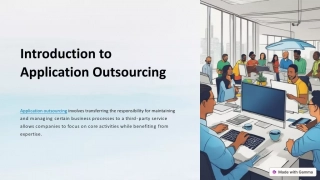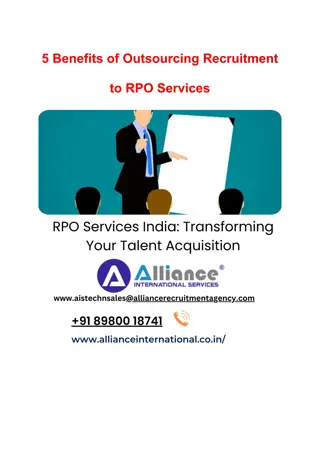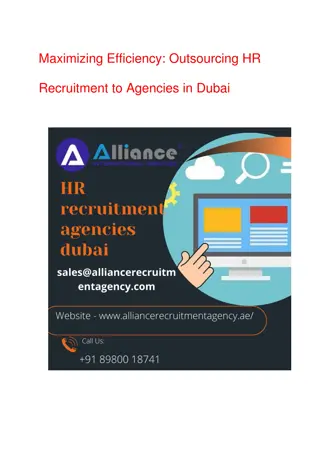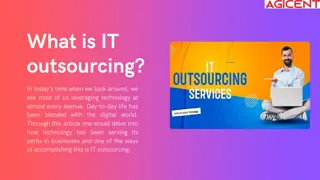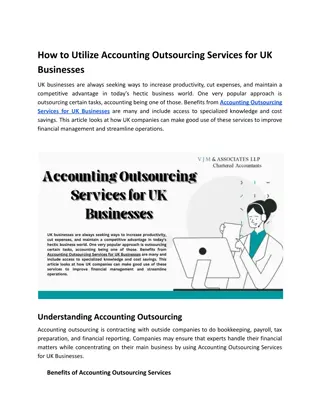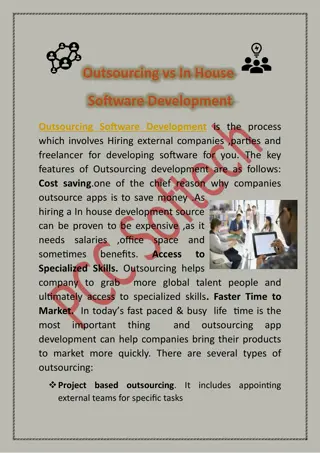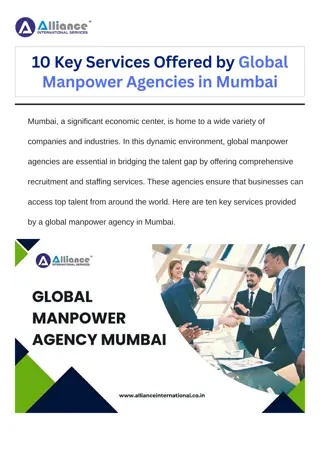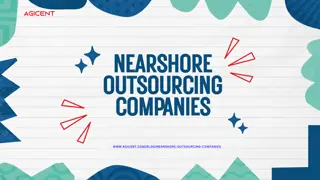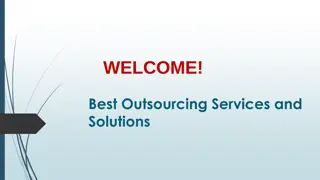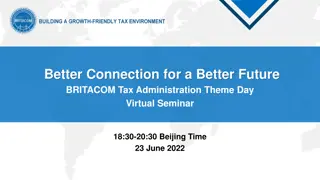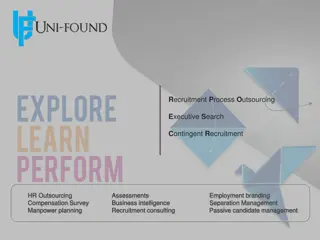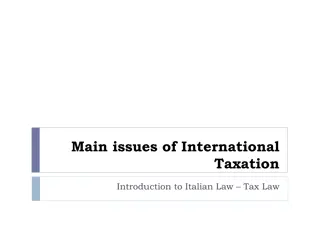Comprehensive Business Solutions for Taxation, Technology, and Outsourcing
Providing a wide range of services including taxation, technology solutions, legal setup, outsourcing, and shared services. Team JHS consists of expert professionals offering turnkey project management for textile manufacturing industries. The focus is on efficient business setup and management to cater to diverse client needs.
Download Presentation

Please find below an Image/Link to download the presentation.
The content on the website is provided AS IS for your information and personal use only. It may not be sold, licensed, or shared on other websites without obtaining consent from the author. Download presentation by click this link. If you encounter any issues during the download, it is possible that the publisher has removed the file from their server.
E N D
Presentation Transcript
TECHNOLOGY TAXATION CA FARHAD WADIA- JHSConsulting Tamara Business Na Tamara Business Na Sharu Sharu ma, Business ma, Business na na Uttar Uttar ane ane Chadhav Chadhav Ma Ma BUSINESS SETUP Risk | Technology | Outsourcing Why and How of Outsourcing and Shared Services Why and How of Outsourcing and Shared Services LEGAL SETUP 2
TAXATION: GST-DGFT-FEMA TECHNOLOGY: KPO Accounts | AP AR I RPA AUTOMATION BUSINESS SETUP: INDIA US UK CANADA UAE A team of 250+ Chartered Accountants and Tax Professionals serving across India-8 offices, US, UK, Canada, UAE
Team JHS is a mix of CPA / CA, Infotech professionals from US, UK, Canada, UAE and India New Business Legal Setup, Accounting, Land Sourcing, Business Reporting Shared Services Compliance & Taxation Filing Financial Planning Temp Staffing TAXATION: GST-DGFT-FEMA TECHNOLOGY: KPO Accounts | AP AR I RPA AUTOMATION BUSINESS SETUP: INDIA US UK CANADA UAE A team of over 250+ Chartered Accountants and Tax Professionals serving across India, US, UK, Canada, UAE
TURNKEY PROJECT MANAGEMENT for Textile Manufacturing Industry Approach We planned the stages of project and allotted the task to each expert team of our organisation. Executing partner was assigned to the client and to oversee each part of the implementation. Referral Partner maintained the birds eye view of the progress and quality of services over a period of 1 year till go live production launch of the company. About Client Increased Employee satisfaction rate Large Textile Company needed Project management in India Increased sales by Delivery Advise the US entity on Land Acquisition Corporate structuring Human Resource & Temp Staffing. Account, Statutory, Transfer Pricing and Internal Control assurance of project in India and liaison with US management and auditors. The Client Need A Niche Textile manufacture catering to the who s who of US society wanted to setup a own manufacturing base from India. Improved customer satisfaction level by turnkey management, accounting,textile manufacturing, human resource, temp staffing www.jhs.consulting
Outsourcing / Offshoring Business Asking the right questions is the key to learning and so below are typical ones! 1. Why & What is Outsource / Offshore? 2. Location of Outsourcer / Offshoring: 3. What is difference between outsourcing and offshoring? 4. Benefit / Reason for Offshoring / Outsourcing 5. What activities can be outsourced/ offshored? 6. How to find Clients, Partners in Foreign Countries? 7. Cost of New Clients Acquisition (from above methods) 8. Preparing office infrastructure 9. Other essentials of outsourcing business? 10. Who Offshores & Who Outsources 11. Problems of Outsourcing
Outsourcing / Offshoring Business 1. Why & What is Outsource / Offshore? a. Outsource is a process of transferring some of the non-core less value adding Manufacturing or Services processes to a third-party vendor. b. Offshoring is the relocation of a business process from one premises/ region/ country to another. c. The basic philosophy being: To move transactional activities to the experts in order to give an organization the capacity to focus on its expertise. 2. Location of Outsourcer / Offshoring: a. The location may be located inside premises of Outsourcer, or in nearby location, different state/region or country. 3. What is difference between outsourcing and offshoring? a. Offshoring means getting work done by an external organization. Offshoring involves setting up of new facility by same Organisation in different location normally a place with better natural resources or skilled/cheaper human resources.
Outsourcing / Offshoring Business 1. Benefit / Reason for Offshoring / Outsourcing a. In Offshoring the benefits would be sustained efficiencies & stability of supply of basic Natural & Human resources without any compromise of control, intellectual property rights, value and culture. b. In Outsourcing the benefits would be same except danger of dependence on another organisation and hence compromise of control, intellectual property rights, value and different culture. But Outsourcing entails lower initial investment and commitments and setup effort and time that Offshoring requires. Hence Medium to Big organisation go for Offshoring which Smaller entities can reap benefits by outsourcing.
What activities can be outsourced/ offshored? 1. What activities can be outsourced/ offshored? a. Products that can be outsourced/offshore/ed: i. Multinational and Mid-sized companies have outsourced/offshored almost all products in various field like petrochemical, plastics, engineering, medicine etc b. Services that can be outsourced: Let us look at how to start outsourcing business tasks, including some options you may not have considered. i. Administrative tasks & hiring Recruitment, Form filing, Data sorting etc ii. Research tasks Content, Graphic, Software, Hardware, Biotech etc iii. Bookkeeping, taxes and accounting tasks Accounting, Tax Preparation, Accounts Payable & Receivables, Data Analysis & Charting. iv. Design and imagery tasks Graphic design, Photograph editing, Videography etc v. Sales tasks Developing Sales Plan, Deliverables, KPI tracking etc vi. Marketing tasks Developing Sales Collaterals, Social Media promotion and Physical Media promotion.
What activities can be outsourced/ offshored? 1. What activities can be outsourced/ offshored? i. Some common outsourcingactivities include 1. Human resource management, 2. Facilities management 3. Supply chain management 4. Accounting 5. Customer support and service 6. Computer aided design 7. Research & development 8. Engineering 9. Diagnostic services 10.Legal documentation
How to find Clients, Partners in Foreign Countries? 1. How to find Clients, Partners in Foreign Countries? a. Who outsources? Typical Sources of outsourced work i. 1st Opportunity: Friends who have moved abroad and who have gone into business they will take a call based on friendship, trust, and confidence in Indian Resident counterpart. Here the billing will be just to maintain cost and salary return to Indian counterpart. i. 2nd Opportunity Depending on the area of your 1st assignment say Motel business Accounting (New Jersey based) you can pitch for succeeding assignment and with testimonial/referrals. Other Motel business in the vicinity (New Jersey, Philadelphia) as well as Relatives and their connects in Motel industry.
How to find Clients, Partners in Foreign Countries? 1. How to find Clients, Partners in Foreign Countries? i. Succeeding Opportunities come from 1. Work outsourcing sites like Guru.com, Fiverr.com, Freelancer.com, upwork.com 2. Conversion of Contacts and Networks of Social Promotion efforts like a. Linkedin b. Facebook c. Google AdWords d. YouTube e. Blog f. Podcast
How to find Clients, Partners in Foreign Countries? 1. How to find Clients, Partners in Foreign Countries? 1. Agents in respective country Outsourcing work a. Certain industries in US have now developed middlemen i. Recruitment industry ii. Infotech iii.Accounting iv.Telecom 2. Trade Fairs a. Most Trade Fairs give particularly good opportunity to participants, but the key is to know who your target is. 3. Trade Association a. Trade association are basically leaders of industry of that region and business so if one becomes a member then they are the 1st prospects. b. Connects of these international local chambers of commerce are the 2nd prospects.
Cost of New Clients Acquisition (from above methods) 1st Opportunity: NIL except few phone calls or Whatsapp 1. a. 2nd Opportunity NIL (At this stage you need Service Brochures prepared by yourself or professionally.) b. Other Motel business in the vicinity -NIL c. Relatives and their connects in similar industry- NIL d. Succeeding Opportunities of outsourcing cost are between $50-100 per year for i. Work outsourcing sites like a. www.Guru.com, b. www.Fiverr.com, c. www.upwork.com d. https://www.truelancer.com/ e. https://www.freelancer.in/ f. https://www.crowdspring.com/ g. https://www.peopleperhour.com/ h. https://expert360.com/
Cost of New Clients Acquisition (from above methods) i. Conversion of Contacts from Social Promotion efforts like a. LinkedIn ($325 to $400 per year options) b. Facebook ($100 - $ 500 monthly spend on add) c. Google AdWords ($100 - $ 500 monthly spend on add) d. YouTube ($0 - $ 500 monthly spend on add) e. Blog - Nil f. Podcast Nil ii. Agents in respective country Outsourcing work a. $ 60000 per year minimum or revenue sharing of 10%-20% and combination of both. iii. Trade Fairs Atleast, $4000 per fair but there is subsidy from Government for this. i. Trade Association ii. $ 5000 per trade association
Preparing office infrastructure Office Space: i. Developed countries have floor space per staff of 50 sq feet but in developing countries it goes down to 25 sq feet. This is because there are fewer car parking, recreational and common amenities mandated. Further the sense and requirement of personal space in populated Asian countries is very low. Rent cost in Indian Cities: A Grade can be Rs 100-250/ sq feet, but can be Rs 35-70 in C Grade. i. Standard BPO/KPO desk consist of space is just enough space for a. 2 screens (3 screens in some cases) b. Thin client c. IP phone. d. 5-6 power plugs with 10-16 Amps circuit breaker. 2 power plugs for Monitors, 1 for Thin Client, 1 for IP phone, 1/2 Free plug (with American and US Sockets) which can be used for other Audio/visual support. e. In most cases a desktop is not needed as most use Centralised cloud servers of client and so need no processing power of desktop computers and thin client technology is in vogue. This also lends to better security.
Preparing office infrastructure Office Space: a. 3-4 nos - RJ45 jacks (1 for PC/Thin Client, 2 for redundancy) connected by CAT 6 cabling and/or access using 1000 MBPS switches dedicated to 2 to 4 User desks. b. Soft but adequate desk lighting c. Personal Foot drawers may also be considered but generally they yield to cluttering with rough work and security risk. Desktop and Desk-Table Cost in Indian Cities: o Screen cost Rs 6500-12000/ screen, o Thin client Rs 9000-18000, o Desk prefab Rs 15000-25000 per unit with electricals but even a stylish Wood and Wrought iron Frame table can be Rs 5000-Rs 7000. General Networking Cost: Minimum Rs 90000 + Internet cost.
Preparing office infrastructure i. Security Aspects: 1.Adequate lighting in Parking, 2.Pick/Drop facilities for night shift staff, 3.Sexual Harassment in Workplace policy and training 4.Video with Audio recording and proper remote back up. i. Other Physical Spaces: 1.Adequate toilets, garbage disposal, sanitation, recreational area, and Canteen space. 2.Reception area should be isolated from workspace and should have standees for Magazines, marketing info., sofa, refreshment for visitors.
Preparing office infrastructure a. Communicating and Control Tool i. Process Control Tools for delegation and reporting like 1. Todoist 2. Jetpack 3. Flock 4. Monday.com i. Communication tools 1. Skype/Zoom/ Webex/ Google Meet/ IP phones 2. Mobile apps like Hylyt-Sociorac (to secure sms, whatapp and email to/between staff).
Pricing Methods and Models a. Pricing methods and Models Various pricing models exist like i. Per Resource ii.Turnkey project iii.Per client of client rate iv.Per Hour rate Thumb rule is Cost of services should not be more than 50% of revenue (excluding Managerial staff and profit). However, this may be till 75% for new processes and clients. Unlike domestic servicing there is a high client acquisition cost, software licencing cost, international standards compliance cost.
Resolving Issues and Other essentials a. Resolving issues i. Delivery issues in Services are easiest if confronted and admitted at first instance. Most of the genuine issues can be resolved. ii. Cultural differences, Geographical distances and Financial arrangements cost unwarranted issues which need to be resolved at a very impersonal but delicate manner. 1. Other essentials of outsourcing business? a. Learn the basics of foreign countries accounting and legal setup. b. Understand the setup of the revenue authority of city, state, Federal and forms for reporting and its periodicity. c. Self learn i. Accounting like QuickBooks, Zoho, Xero ii. Tax software of each county like US Drake, Turbo Tax, Pro Series iii.Productivity and Control Tools iv.Technology like VPN, Router, Cloud storage, Terminal Server, Internet service protocols, Fire Wall etc.
Who Offshores & Who Outsources ? 1. Who Offshores & Who Outsources ? i. Typical Offshore entity are established and large entities looking for a Cost, Time and Quality advantage in another geographical location. ii. Typical Offshore entities size range small to established entities also looking for a Cost, Time and Quality advantage in another geographical location. However they are also looking for growth through you (outsource provider) so are in a way dependent on outsource provider to develop systems, procedures and methods to deliver the benefits as also free them of their daily chores so as to acquire more business to outsource. 1. Typical Age of outsourcers is between 35 -55 years as a. they are looking to enter a market but need an advantage over the established players b. have about 10-20 years of active business life left c. can understand, adopt, and grow using technology. d. Those who put effort into a systematic approach
Who Offshores & Who Outsources ? Typically, Outsourcers have one business but multiple location or multiple business and multiple locations. a.To manage Sales, Pricing, Logistics, Inventory is a major challenge and a centralised data processing centre is needed. So it doesn t hurt to have it at 2/3rd the cost, 24/7 hour service, better educated and even is situated half the way around the globe.
Problems of Offshoring 1. Problems of Offshoring a. Cost-Reduction Expectations i. The biggest risk with offshore outsourcing has nothing to do with outsourcing - it involves the expectations the internal organization has about how much the savings from offshore will be. Unfortunately, many executives assume that labour arbitrage will yield savings comparable to person-to-person comparison (for example, a full-time equivalent in India will cost 40 percent less) without regard for the hidden costs and differences in operating models. In reality, most IT organizations save 15 percent to 25 percent during the first year; by the third year, cost savings often reach 35 percent to 40 percent as companies "go up the learning curve" for offshore outsourcing and modify operations to align to an offshore model. b. Data Security/Protection i. IT organizations evaluating any kind of outsourcing question whether vendors have sufficiently robust security practices and if vendors can meet the security requirements they have internally. While most IT organizations find offshore vendor security practices impressive (often exceeding internal practices), the risk of security breaks or intellectual property protection is inherently raised when working in international business. Privacy concerns must be completely addressed. Although these issues rarely pose major impediments to outsourcing, the requirements must be documented and the methods and integration with vendors defined. c. Process Discipline (CMM) i. The Capability Maturity Model (CMM) becomes an important measure of a company's readiness to adopt an offshore model. Offshore vendors require a standardized and repeatable model, which is why CMM Level 5 is a common characteristic. It is observed that approximately 70 percent of IT organizations are at CMM Level 1 - creating a gap that is compensated for by additional vendor resources on-sit. Companies lacking internal process model maturity will undermine potential cost savings.
Problems of Offshoring 1. Problems of Offshoring a. Loss of Business Knowledge i. Most IT organizations have business knowledge that resides within the developers of applications. In some cases, this expertise may be a proprietary or competitive advantage. Companies must carefully assess business knowledge and determine if moving it either outside the company or to an offshore location will compromise company practices. a. Vendor Failure to Deliver i. A common oversight for IT organizations is a contingency plan - what happens if the vendor, all best intentions and contracts aside, simply fails to deliver. Although such failures are exceptions, they do occur, even with the superb quality methodologies of offshore vendors. When considering outsourcing, IT organizations should assess the implications of vendor failure (such as, does failure have significant business performance implications?). High risk or exposure might deter the organization from outsourcing, it might shift the outsourcing strategy (e.g., from a single vendor to multiple vendors), or it might drive the company toward outsourcing (if the vendor has specific skills to reduce risks). The results of risk analysis vary between companies; it is the process of risk analysis that is paramount. b. Scope Creep i. There is no such thing as a fixed-price contract. All outsourcing contracts contain baselines and assumptions. If the actual work varies from estimates, the client will pay the difference. This simple fact has become a major obstacle for IT organizations that are surprised that the price was not "fixed" or that the vendor expects to be paid for incremental scope changes. Most projects change by 10 percent to 15 percent during the development cycle.
Problems of Offshoring 1. Problems of Offshoring a. Government Oversight/Regulation i. Utilities, financial services institutions, and healthcare organizations, among others, face various degrees of government oversight. These IT organizations must ensure that the offshore vendor is sensitive to industry-specific requirements and the vendor's ability to: 1) comply with government regulations; and 2) provide sufficient "transparency" showing that it does comply and is thus accountable during audits. The issue of transparency is becoming more significant as requirements such as the USA PATRIOT Act and the Sarbanes-Oxley Act place greater burdens of accountability on all American corporations. b. Culture i. A representative example: although English is one official language in India, pronunciation and accents can vary tremendously. Many vendors put call-center employees through accent training. In addition, cultural differences include religions, modes of dress, social activities, and even the way a question is answered. Most leading vendors have cultural education programs, but executives should not assume that cultural alignment will be insignificant or trivial. c. Turnover of Key Personnel i. Rapid growth among outsourcing vendors has created a dynamic labour market, especially in Bangalore, India. Key personnel are usually in demand for new, high-profile projects, or even at risk of being recruited by other offshore vendors. While offshore vendors will often quote overall turnover statistics that appear relatively low, the more important statistic to manage is the turnover of key personnel on an account.
Problems of Offshoring 1. Problems of Offshoring a. Knowledge Transfer i. The time and effort to transfer knowledge to the vendor is a cost rarely accounted for by IT organizations. Indeed, we observe that most IT organizations experience a 20 percent decline in productivity during the first year of an agreement, largely due to time spent transferring both technical and business knowledge to the vendor. Many offshore vendors are deploying video conferencing (avoiding travel) and classroom settings (creating one-to-many transfer) to improve the efficacy of knowledge transfer. In addition, employee turnover often places a burden on the IT organization to provide additional information for new team members. b. Business Impact: i. Offshore outsourcing can reduce IT expenditures by 15 percent to 25 percent within the first year. Longer term, process improvements often make great impacts on both cost savings and the quality of IT services delivered. Ultimately its all about making a connection, setting up the agreement and service line and exceeding the expected quality of delivery.
My Gives My Asks 3 Type of business owners 1) Business Owners who want to take their business to greater heights. 2) Business Owners who want to increase profitability and reduce cost 3) Business Owners whose business are facing turbulent times 4) Professional like CA, CS, Advocate, IT professionals with whom we can collaborate.
Our Offices: India and Worldwide Metro Offices: Gujarat Offices: Worldwide Offices: London, Dubai, Houston Mumbai, Delhi, Kolkata, Bangalore Ahmedabad, Vadodara, Vapi In conclusion our goal is to setup a marketing function which is dependable, economical and result oriented to your present and future Projects. Thank you. Contact us: info@jhsconsulting.in Call us: +91 989 855 0767 +1 832 941 1862
THANK YOU THANK YOU












